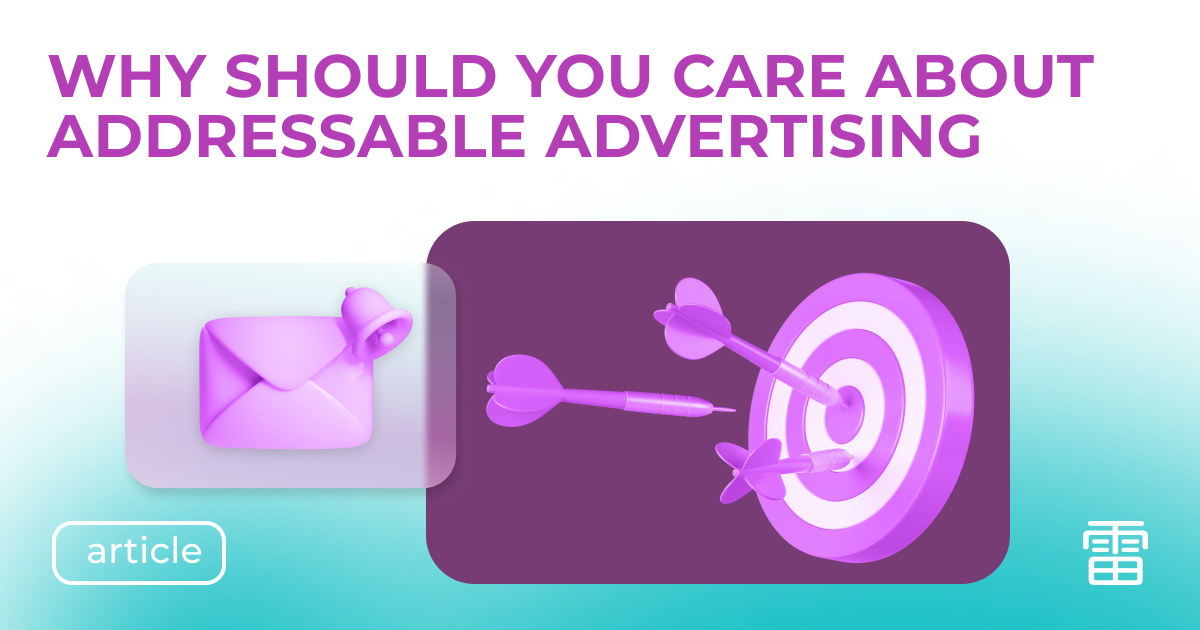If you’ve been wondering how to improve your ad performance, make your campaigns more effective, and, just as importantly, stay on top of trends, let’s talk about addressable advertising. Think of it as a personal stylist for your brand — it helps you deliver the perfect message to every customer. Let’s dive into why addressable advertising is more than just a buzzword and has become a critical element of modern digital strategy.
What Is Addressable Advertising?
Addressable advertising is when your message "knocks on the right door." Unlike non-addressable advertising, which operates on the principle of "shooting a cannon at sparrows," addressable advertising knows exactly where to go and whom to reach.
Key features of addressable advertising:
- Targeting specific audiences — Ads are shown only to people who are likely to be interested.
- Measurable effectiveness — You can see exactly who viewed your ad, who clicked on it, and who made a purchase.
- Personalization — Content is tailored to audience preferences, behavior, and even current needs.
Now let’s take a moment to look at non-addressable advertising. This includes traditional ads on TV, radio, or roadside billboards. While it still has its place, its main drawback is that it focuses on reach without knowing who actually saw the message. In an era where businesses aim for maximum efficiency, this is far from ideal for forward-thinking companies.
How Does Addressable Advertising Work?
Imagine walking into a coffee shop, and the barista not only knows your name but also remembers that you love a cappuccino with almond milk. That’s how addressable advertising operates: it collects data and uses it to align with your preferences.
An addressable audience is defined by factors such as:
- Geolocation (for instance, showing ads for umbrellas only in areas where it’s raining).
- Age, gender, and interests.
- Purchase history and activity.
Examples in action:
- You’re looking for a new smartphone. After visiting a gadget review site, you start seeing ads with great deals on smartphones.
- You’ve booked a theater ticket, and soon you’re served ads for nearby restaurants where you can dine before the show.
The Evolution of Addressable Advertising
It all began with paper mail and discount coupons. Then came email marketing, which marked the first steps toward targeting.
Today, we live in a digital age where addressable advertising has reached new heights, especially in channels like:
- Social media — Platforms like Facebook, Instagram, and TikTok use user data for ultra-precise targeting.
- OTT and Smart TV — Ads are tailored to your preferences by analyzing your viewing habits.
- DOOH (Digital Out-of-Home) — Digital billboards can change their content based on the time of day, weather, or even pedestrian traffic density.
But it’s not all smooth sailing. The disappearance of cookies, for instance, has caused quite a stir in the advertising world. Brands have started exploring new approaches, from contextual targeting to technologies like Google’s FLoC and FLEDGE, which enable targeting without personal data.
Why Is Addressable Advertising So Important?
Modern customers demand attention. They expect businesses to understand their needs while respecting their privacy. Addressable advertising strikes this perfect balance.
- Efficiency — You spend your budget only on the audience genuinely interested in your product.
- Transparency — Modern tools let you track every penny of your advertising budget.
- Adaptability — Amid tightening data privacy regulations, addressable advertising provides creative and compliant solutions.
Addressable Advertising Across Different Channels
- Social media — Advertising here relies on first-party data—information users willingly share with the platform, such as posts they like and accounts they follow.
- OTT and Smart TV — Behavioral analysis comes into play. For instance, if you watch sports, you might see ads for athletic gear.
- DOOH — Ads on digital screens at bus stops or malls adapt based on weather, holidays, or even traffic conditions.
Solutions for Modern Addressable Advertising
In an era where privacy is paramount, it’s crucial to use tools that respect user boundaries while delivering results.
Some solutions include:
- Contextual targeting — Ads are based on page content rather than user data. For example, if you’re reading a travel article, you might see an ad for airline tickets.
- Google’s technologies — FLoC and FLEDGE group users into anonymous cohorts based on behavior, allowing targeting without identifying individuals.
Conclusion
In conclusion, addressable advertising isn’t just the future of marketing — it’s the present. It empowers businesses to connect with their audience in meaningful ways, delivering personalized messages while respecting privacy boundaries. With its ability to optimize ad spend, enhance transparency, and adapt to ever-changing digital landscapes, addressable advertising is an essential tool for any business looking to stay competitive and relevant.

